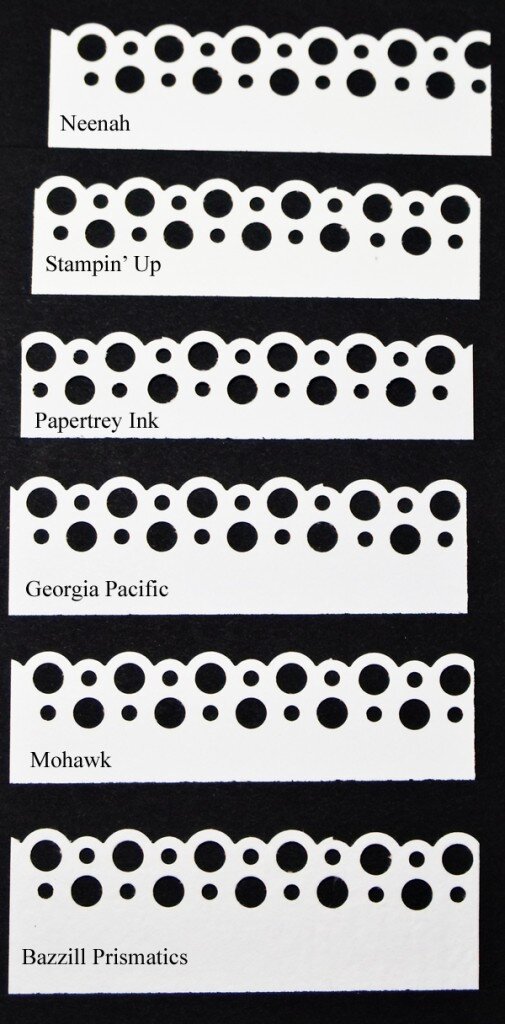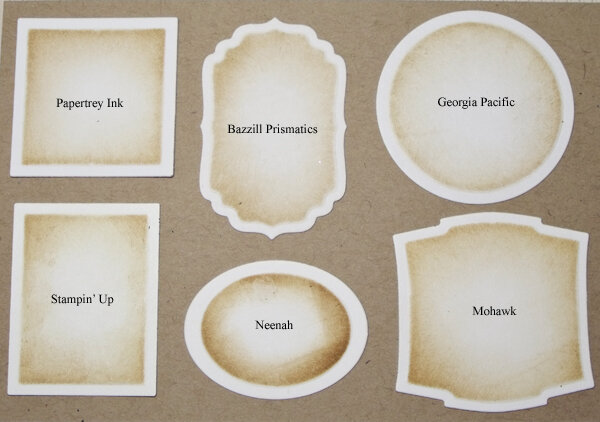White Card Stock Comparison
Reported by Taylor Usry
There are so many options out there for white card stock! With the popularity of both clean and simple (CAS) cards, as well as detailed images that can be colored with markers or any other coloring medium, choosing the right white for your project can get tricky. Today I'm going to show you how different techniques work on several popular white card stocks - Neenah Solar White, Papertrey Ink Stamper's Select, Stampin Up!' Whisper White, Bazzill's Prismatics Textured White, Mohawk's Color Copy 98 Bright White, and Georgia Pacific's White card stock.

Here is a quick overview of each card stock:
- Neenah Solar White: 80# weight, acid-free, ultra-smooth finish; widely available in packs of 25, or by the ream, online
- Papertrey Ink's Stamper's Select: 110# weight; only available in packs of 40 sheets through their website
- Stampin' Up's Whisper White: 80# weight; only available in packs of 40 sheets through a demonstrator
- Bazzill's Prismatics Textured White: 70# weight, textured on one side and smooth on the other; available online
- Mohawk's Color Copy 98 Bright White: 100# weight, acid-free; available by the ream or large pack online
- Georgia Pacific's White: 110# weight; available in large packs online and in retail stores such as WalMart, Staples, etc
The Neenah, Mohawk, and Stampin' Up card stocks have the smoothest, glossy-type finish. Papertrey ink is also incredibly smooth, but it isn't quite as glossy. Bazzill's Prismatics has one textured side (in a mottled, orange peel finish) and one flat side (but not smooth and glossy to the touch). Georgia Pacific's card stock is just flat. In terms of weight, although Stampin' Up's card stock is 80#, it feels much flimsier than Neenah's. And while the Georgia Pacific is purported to be 110#, it feels flimsy as well. I don't particularly advocate using either the Stampin' Up or the Georgia Pacific as a card base. All of the others are quite sturdy and thick.

All of the card stocks work well when used with a paper punch (here, a Martha Stewart one). I did notice that the Georgia Pacific card stock did not punch as cleanly as the others did. Some edges needed filing or smoothing several times, both when using an edge punch and a standard shaped punch.

Next I cut each image out using a different Spellbinder's Nestabilites die, and left the card stock plain inside each one to do some sponging using Tim Holtz ink.. The smooth finish on the Neenah, Mohawk, and Papertrey Ink card stock provided the best surface for the blended sponging effect. Stampin' Up's card stock also has a smooth surface, but I don't think the ink blended as well. I like the way the sponging turned out on the textured card stock by Bazzill as well, but again it is not a smooth finish. It still blends well, though. The Georgia Pacific does an okay job - but just okay. I found that the ink didn't want to blend as easily as with the others, so the changes in colors were more noticeable. As you can see, the Neenah card stock took the ink really well; it is the darkest of all. I sponged each piece exactly the same, to demonstrate the variations of the inks once they'd been applied.

On these I partially colored a variety of Stampendous images with Copics. All images were stamped in Memento Tuxedo Black ink and had fifteen minutes of drying time, but were not heat-set. Stampin' Up's Whisper White is not at all suitable for coloring with Copics - it doesn't blend. Georgia Pacific's card stock is mediocre - it blends alright, but occasionally you can see streaks, and the lines between colors can be harsh. Papertrey Ink, Mohawk (which is not pictured above, but you will see it in a minute - stick with me!) and Neenah's card stocks have an excellent surface for Copic coloring, and all blend beautifully. The Bazzill Prismatics also colors gorgeously, but I noticed a bit more bleeding (that could be due to not heat-setting my ink, but I didn't do that on purpose). In my opinion, the Papertrey Ink is such a heavy weight that is sucks up lots of Copic ink, which then necessitates quicker refills.

Lastly, I stamped some solid images on each card stock (using acrylic stamps from Sweet 'n Sassy Stamps and Tim Holtz ink), to see what kind of coverage I got. The only one I was underwhelmed with was the Georgia Pacific card stock. Bazzill's Prismatics stamp better on the smooth side than the textured side; you can see the mottled look the textured side gives. The others all have a smooth finish and take ink very well. Drying time varies a bit with each card stock, but none took longer than five minutes. Again, the Neenah card stock had a darker color than all the other smooth card stocks.

On this sample, I colored that Stampendous image using Copics on the Mohawk card stock. The base and embossed layer are Papertrey Ink. All of the card stocks emboss equally as well. For me, the Papertrey Ink provides the strongest base. It is not flimsy at all, and you can add as many layers or heavy embellishments as you want.
I also ran a few sheets through my printer, to see how well they worked with digital images and papers. I have an HP inkjet printer. The Papertrey Ink card stock was too thick to consistently go through my printer - they had quite an argument. The Neenah, Mohawk, Georgia Pacific, Bazzill Prismatics, and Stampin' Up all fed through just fine, and worked great for digi images. The smooth-finish card stocks (not the Georgia Pacific or Bazzill Prismatics) worked better for printing digital paper on (*tip: run it through twice, to create your own double-sided patterned paper!).
What card stock is your favorite for coloring on? Do you use it for rubber stamping, printing and coloring digital images, or scrapbooking? I'd love to hear your thoughts and suggestions!
